NEW! E-BOOKS (PDF)
NEW! SBI PO Study Notes | IBPS PO Exam
(Papers) SBI Clerk Exam Paper - 2009 (Reasoning Ability)
(Paper) SBI Clerk Exam Paper - 2009
:: REASONING ABILITY ::
121. How many such pairs of letters are there in the word BRIGHTEN each of which has as many letters between them in the word as in the English alphabet ?
(1) None
(2) One
(3) Two
(4) Three
(5) More than three
122. In a certain code FIGHT is writ ten as '39%@4' and TEARS is written as '458(F)*'. How is STAGE written in that code ?
(1) •4835
(2) *48%5
(3) •84%5
(4) *48@5
(5) None of these
DOWNLOAD SBI CLERK Question Papers PDF
DOWNLOAD SBI PO Question Papers PDF
DOWNLOAD MORE BANK EXAMS E-BOOKS
Buy Printed Study Material for SBI Clerk Exam
123. Among A, B, C, D and E each reaching school at a different time, C reaches before D and A and only after 3. E is not the last to reach school. Who among them reached school last ?
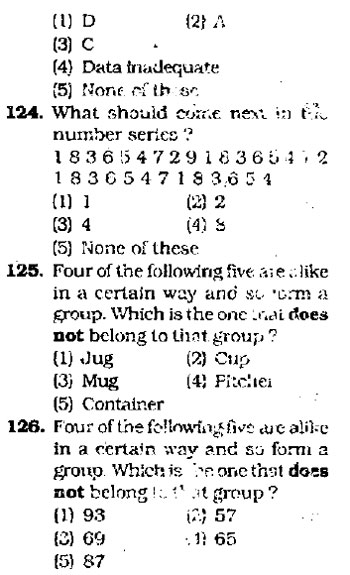

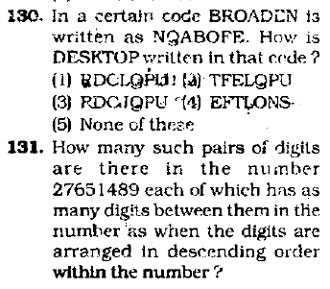


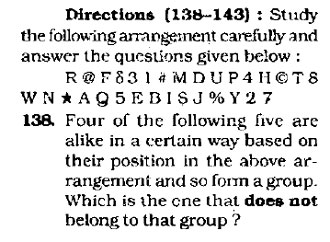
(1) M D 1
(2) 4 H P
(3) 3 W T
(4} Q 5 A
(5) J % $
139. How many such symbols are there in the above arrangement, each of which is immediately preceded by a number and immediately followed by a letter ?
(1) None
(2) One
(3) Two
(4) Three
(5) More than three
140. If all the numbers are dropped from the above arrangement, which of the following will be the eleventh from the left end ?
(1) P
(2) Q
(3) N
(4) ©
(5) None of these
141. What should come next in the following series based on the above arrangement ?
F 3 1 DP4 TWN ?
(1) 5 B I
(2) Q E I
(3) Q E B
(4) Q 5 B
(5) None of these
142. How many such numbers are there in the above arrangement, each of which is immediately preceded by a consonant and also immediately followed by a consonant ?
(1) None
(2) One
(3) Two
(4) Three
(5) More than three
143. Which of the following is the eighth to the right of the seventeenth from the right end of the above arrangement ?
(i) E
(2) D
(3) #
(4) I
(5) None of these
Directions (144-149): In each of the questions below are given three statements followed by three conclusions numbered I, II and III. You have to take the given statements to be true even if they seem to be at variance from commonly known facts. Read all the conclusions and then decide which of the given conclusions logically follows from the given statements disregarding commonly known facts.
144. Statements:
All telephones are wires.
All wires are tents.
All tents are cans.
Conclusions:
I. Some cans are wires.
II. Some tents are telephones.
III. Some cans are telephones.
(1) Only I and II follow
(2) Only II and III follow
(3) Only I and III follow
(4) All I, II and III follow
(5) None of these
145. Statements:
Some cards are pictures.
All pictures are paints.
Some paints are nails.
Conclusions:
I. Some paints are cards.
II. Some nails are cards.
III. Some nails are pictures.
(1) None follows
(2) Only I follows
(3) Only II follows
(4) Only III follows
(5) Only I and II follow
146. Statements:
All walls are glasses.
No glass is table.
Some tables are windows.
Conclusions:
I. Some windows are walls.
II. Some tables are walls.
III. Some windows glasses.
(1) None follows
(2) Only I follows
(3) Only II follows
(4) Only III follows
(5) Only I and II follow
147. Statements:
All baskets are poles.
Some poles are lamps.
All lamps are roads.
Conclusions:
I. Some lamps are baskets.
II. Some roads are poles.
III. Some lamps are poles.
(1) Only I and II follow
(2) Only I and III follow
(3) Only II and III follow
(4) All I, II and III follow
(5) None of these
148. Statements:
Some leaves are baskets.
Some baskets are flowers.
Some flowers are lakes.
Conclusions :
I. Some lakes are baskets.
II. Some flowers are lakes.
III. No lake is basket.
(1) Only I follows
(2) Only II follows
(3) Only III follows
(4) Only either I or III follows
(5! None of these
149. Statements:
AH rtcttiircs are bands.
Some bands are chairs.
Some chairs are tables.
Conclusions :
I. Some tables are bands.
II. Some chairs are pictures.
III. Some tables are pictures.
(1) None follows
(2) Only 1 follows
(3) Only II follows
(4) Only I and II follow
(5) Only III follows
Directions (150-155) : In the following questions, the symbols @, 8, •k, $ and % are used with the following meanings as illustrated below :
'P 8 Q' means 'P is not smaller than Q'.
'P * Q' means 'P is not greater than Q'.
'P % Q' means 'P is neither greater than nor equal to Q'.
'P $ Q' means 'P is neither smaller than nor equal to Q'.
'P @ Q' means 'P is neither greater than nor smaller than Q'.
Now in each of the following questions assuming the given statements to be true, find which of the three conclusions I, II and III given below them is/are definitely true and give your answer accordingly.
150. Statements:
B % N, N 8 F, F • H
Conclusions :
I. H $ N
II. F % B
III. B % H
(1) Only I and II are true
(2) Only I and III are true
(3) Only II and III are true
(4) None is true
(5) All I, II and III are true
151. Statements:
W 8 F, F % K, K $ M
Conclusions :
I. M % F
II. M 8 F
III. W $ K
(1) Only I is true
(2) Only II true
(3) Only either I or II is true
(4) Only III is true
(5) None of these
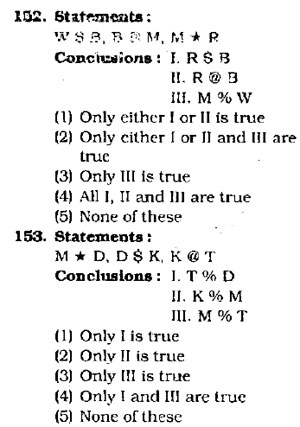
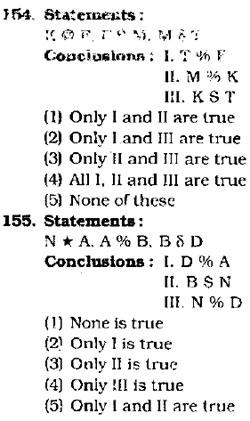
Directions (156 - 160): In each of the questions given below which one of the five answer figures on the right should come after the problem figures on the left, if the sequence were continued ?



